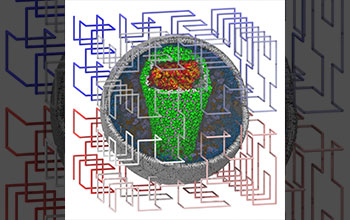Multimedia Gallery
Mature "virion" of type-1 HIV-1, with certain regions exposed for clarity
A simplified representation of a mature "virion" of type-1 human immunodeficiency virus (HIV-1), with certain regions exposed for clarity. A virion is an entire virus particle and consists of an outer protein shell, called a capsid, and an inner core of nucleic acid (either ribonucleic or deoxyribonucleic acid--RNA or DNA). Virions are released from the surface of a cell infected with HIV-1 and feature these main components: An external membrane enclosing the virion (gray) and a cone-shaped capsid made of special proteins (green) that surround the genetic material of the virus (red and orange).
Greg Voth, the Haig P. Papazian Distinguished Service Professor of Chemistry at the University of Chicago, and his team use CMTS (cable modem termination system) software to efficiently model systems such as this HIV-1 virion by splitting the overall structure into smaller pieces. These smaller pieces are then examined in parallel by large numbers of central processing units (CPUs) on the Blue Waters supercomputer, located at the National Center for Supercomputing Applications (NCSA) at the University of Illinois at Urbana-Champaign. To help ensure that no CPU performs too many calculations, the CMTS software splits up the overall workload using a Hilbert curve--a mathematical concept that describes 3-D locations using only a single number. An example of a Hilbert curve is shown surrounding the virion, changing color from blue to red as it moves through 3-D space.
This material is based on work supported by the National Science Foundation (NSF) through the Center for Multiscale Theory and Simulation (grant CHE 11-36709), the Blue Waters sustained-petascale computing project (grant OCI 07-25070), and the "Petascale Multiscale Simulations of Biomolecular Systems" NSF PRAC allocation (grant OCI 10-36184). Blue Waters is supported by NSF through grants ACI 07-25070 and ACI 12-38993.
To learn more about this research, see the NCSA news story Really big problems. (Date of Image: January 2014)
Credit: Prof. Gregory A. Voth, The University of Chicago
Images and other media in the National Science Foundation Multimedia Gallery are available for use in print and electronic material by NSF employees, members of the media, university staff, teachers and the general public. All media in the gallery are intended for personal, educational and nonprofit/non-commercial use only.
Images credited to the National Science Foundation, a federal agency, are in the public domain. The images were created by employees of the United States Government as part of their official duties or prepared by contractors as "works for hire" for NSF. You may freely use NSF-credited images and, at your discretion, credit NSF with a "Courtesy: National Science Foundation" notation.
Additional information about general usage can be found in Conditions.
Also Available:
Download the high-resolution JPG version of the image. (5.7 MB)
Use your mouse to right-click (Mac users may need to Ctrl-click) the link above and choose the option that will save the file or target to your computer.



